To capture stunning indoor drone footage, you'll need the right equipment and techniques. Choose a compact drone with prop guards and obstacle avoidance. Prioritize safety by securing the area and using spotters. Master slow, steady movements and practice maneuvering tight spaces. Utilize natural light and experiment with LED panels for dramatic effects. Incorporate doorways and windows as frames to enhance depth and composition. Focus on unique angles and perspectives to showcase architectural features. Don't forget to plan smooth shifts between spaces and perfect your reveal shots. With these secrets, you'll be well on your way to creating cinematic indoor masterpieces.
Choosing the Right Drone
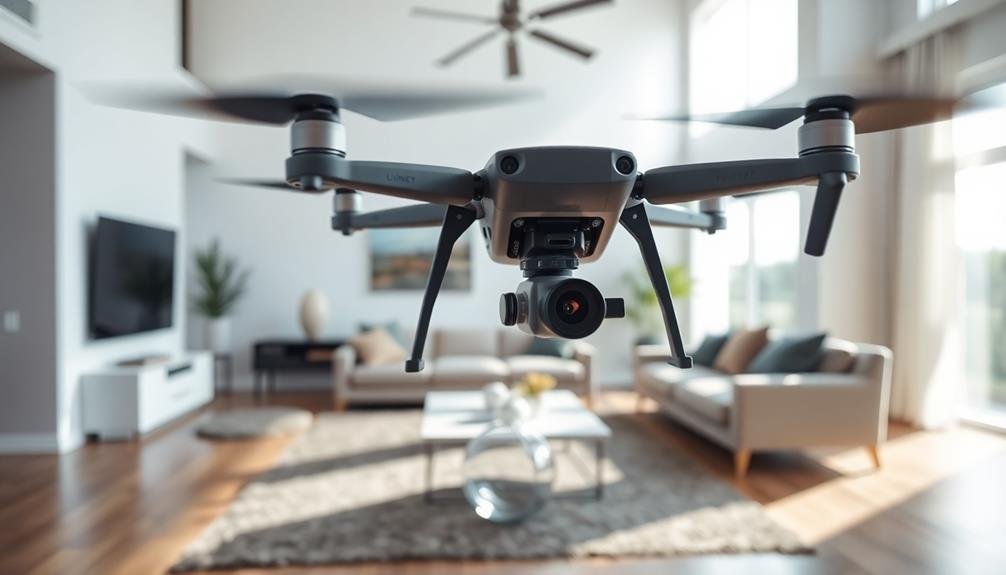
Drones come in all shapes and sizes, but not all are suited for indoor flight. When selecting a drone for interior shots, prioritize compact models with prop guards. These features protect both your drone and surroundings from accidental collisions.
Look for drones specifically designed for indoor use, as they often have more stable flight characteristics and enhanced obstacle avoidance systems.
Consider the drone's camera quality and stabilization features. You'll want a model that can capture smooth, high-resolution footage even in tight spaces. Opt for drones with adjustable flight speeds and responsive controls, allowing you to maneuver precisely through narrow corridors and around furniture.
Battery life is essential for indoor shoots. Choose a drone with sufficient flight time to complete your shots without frequent interruptions. Additionally, consider the noise level of the drone. Quieter models are less disruptive and more suitable for indoor environments.
Lastly, make sure your chosen drone has a reliable return-to-home feature and altitude hold capabilities. These functions provide added safety and stability during indoor flights, especially in areas with poor GPS reception.
Essential Indoor Flight Safety Precautions
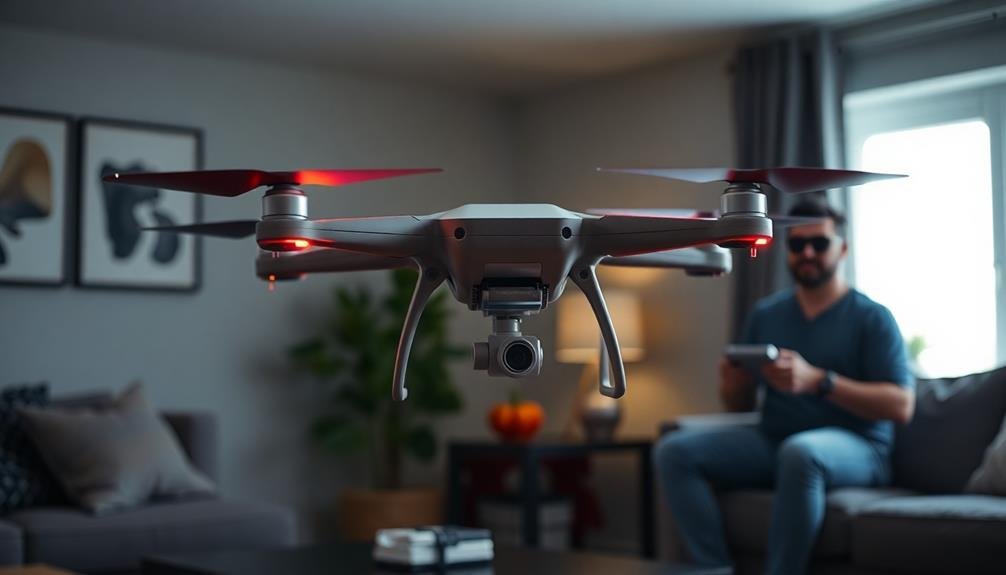
When flying indoors, your top priority should be protecting people and property from potential drone accidents.
You'll need to establish a clear flight area, remove fragile items, and warn others about your flight plans.
It's also vital to prepare for emergencies by having a first aid kit on hand and knowing how to quickly shut down your drone in case of malfunction.
Protect People and Property
Safety should be your top priority when flying drones indoors. To protect people and property, always maintain a safe distance from individuals and objects. Keep your drone at least 10 feet away from people and fragile items. Never fly directly over anyone's head, as this poses a significant risk if your drone malfunctions or loses power.
Secure loose objects in the room before flight, as prop wash can cause lightweight items to become airborne. Remove or cover valuable items that could be damaged if your drone crashes. Use propeller guards to minimize potential damage and injury in case of collisions. Always have a spotter to help you navigate and warn of potential hazards.
Be mindful of reflective surfaces like mirrors and windows, which can interfere with obstacle avoidance systems. Verify proper lighting to maintain visual line of sight with your drone at all times.
Consider using foam padding on walls or creating designated "crash zones" with soft materials to absorb impact. Finally, have a pre-flight checklist to verify all safety measures are in place before takeoff, and conduct a thorough post-flight inspection to identify any damage or issues that need addressing.
Prepare for Emergencies
Three essential emergency preparations are crucial for indoor drone flight safety. First, always have a fire extinguisher readily available. Lithium-polymer batteries can ignite if damaged, so you'll need to act quickly to prevent a disaster. Second, keep a first aid kit nearby to treat any minor injuries that might occur during flight or handling. Third, memorize the location of emergency exits and verify they're unobstructed.
To further enhance your emergency preparedness, consider these additional measures:
| Preparation | Purpose | Implementation |
|---|---|---|
| Spotter Training | Assist pilot, monitor surroundings | Teach basic flight controls, communication signals |
| Prop Guards | Protect people and objects from spinning blades | Install before each flight, check for secure fit |
| Kill Switch | Instantly stop motors in emergencies | Practice using it regularly, keep within reach |
Lighting Techniques for Indoor Shots
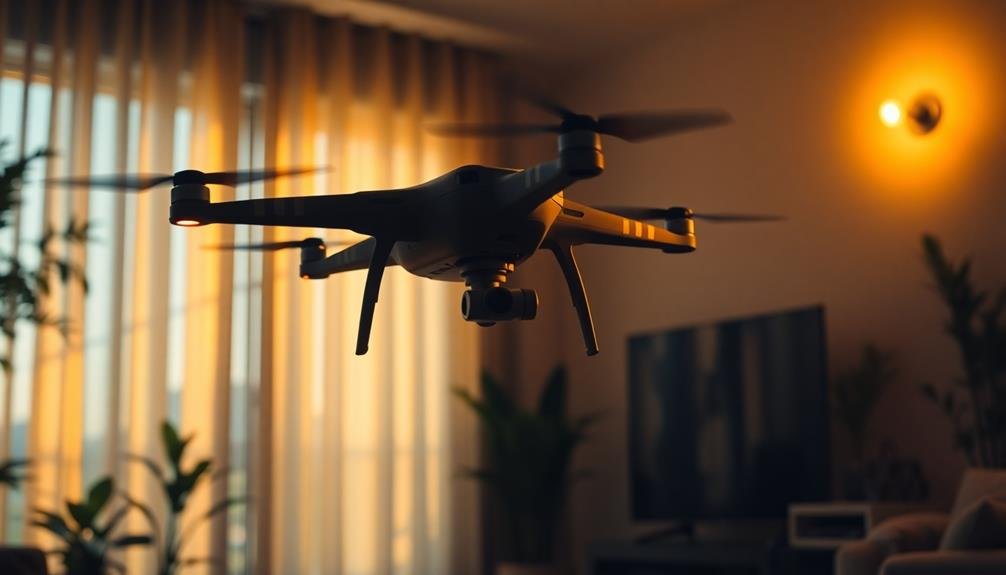
Mastering lighting techniques is essential for capturing stunning indoor shots with your drone. You'll need to understand how different light sources interact with your subject and camera settings.
Start by identifying the primary light sources in your indoor space, whether they're natural or artificial. You'll want to position your drone to take advantage of these light sources, using them to create depth and dimension in your shots.
Don't be afraid to experiment with different lighting setups. Try using external LED lights mounted on your drone or placed strategically around the room. You can also use reflectors to bounce light onto your subject, creating a softer, more flattering look.
Remember to adjust your camera settings accordingly, paying close attention to ISO, shutter speed, and aperture.
Consider these lighting techniques for dramatic indoor shots:
- Backlighting your subject to create a silhouette effect
- Using side lighting to highlight textures and contours
- Implementing low-key lighting for a moody, atmospheric feel
Always be mindful of shadows and how they impact your composition.
Mastering Slow and Steady Movements
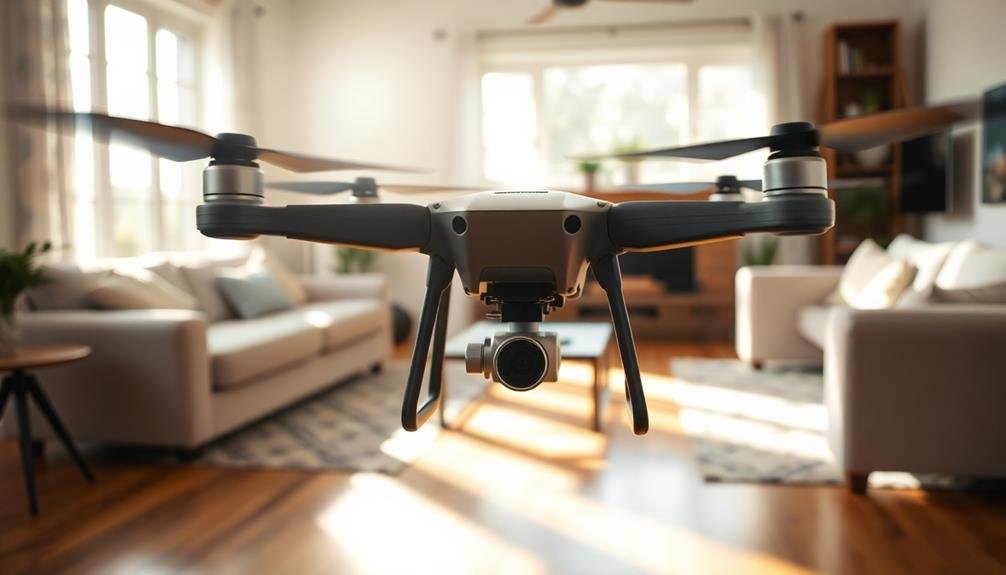
When it comes to indoor drone flying, slow and steady movements are your secret weapon for capturing smooth, professional-looking footage. To master this technique, start by adjusting your drone's settings. Lower the maximum speed and reduce control sensitivity to prevent sudden jerks or rapid movements.
Practice flying in straight lines, maintaining a consistent speed and altitude. Use visual markers in the room to help you stay on track. When turning corners, execute gentle, gradual movements rather than sharp turns. This approach will result in more cinematic shots and reduce the risk of collisions.
For panning shots, rotate your drone slowly around its axis while keeping it stationary. To achieve smooth vertical movements, use the altitude control gently and steadily. When moving towards or away from a subject, maintain a constant speed to create a sense of depth and perspective.
Remember to anticipate obstacles and plan your flight path in advance. This foresight will help you avoid abrupt changes in direction or speed.
Utilizing Natural Frames and Doorways
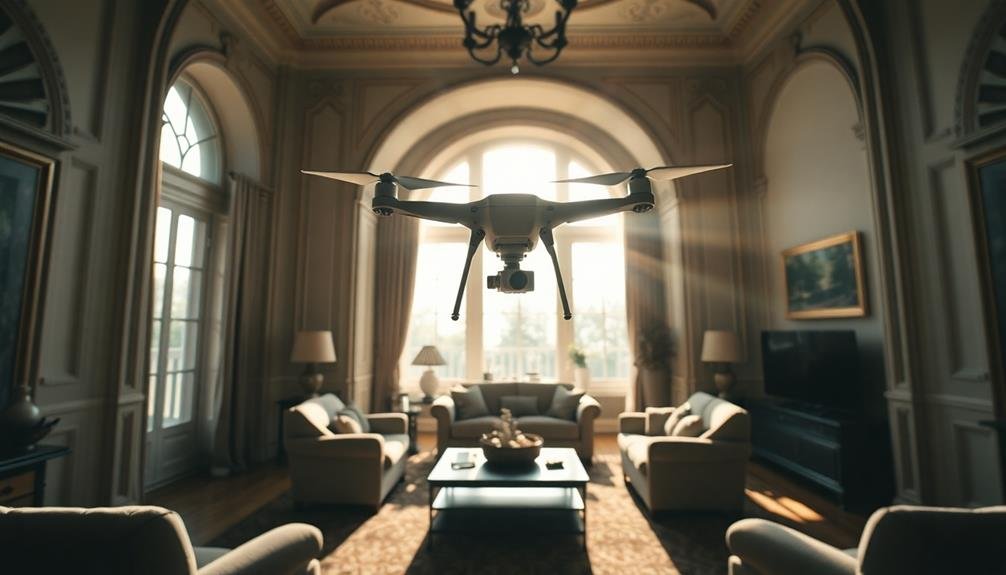
As you navigate indoor spaces with your drone, pay attention to natural frames and doorways to enhance your footage.
You'll find that shooting through these elements can create visual impact and add depth to your shots.
Framing for Visual Impact
Creativity in framing can elevate your indoor drone shots from ordinary to extraordinary. As you explore natural frames and doorways, consider how you can use them to add depth and context to your footage. Position your drone to capture subjects through these frames, creating a sense of discovery and intrigue.
Experiment with different angles and distances to find the most visually appealing composition. Don't limit yourself to obvious frames like doorways and windows. Look for unconventional framing opportunities such as:
- The curve of a spiral staircase
- The space between hanging light fixtures
- The gaps in a bookshelf or room divider
Remember that framing isn't just about enclosing your subject. It's about guiding the viewer's eye and creating visual interest. Use leading lines within your frames to draw attention to specific areas of your shot.
Play with symmetry and asymmetry to create balance or tension in your composition. By carefully considering your framing choices, you'll add layers of meaning and visual appeal to your indoor drone footage, transforming simple spaces into enchanting cinematic scenes.
Creating Depth Perception
Natural frames and doorways serve as powerful tools for creating depth perception in your indoor drone shots. When you're flying indoors, use these architectural elements to your advantage. Position your drone to capture a subject through a doorway or window, creating a frame within your frame. This technique instantly adds layers to your composition and draws the viewer's eye into the scene.
To enhance depth perception, fly your drone from one room to another, passing through doorways or arches. This movement creates a dynamic shift that emphasizes the space between foreground and background. You can also use staircases or hallways to create leading lines, guiding the viewer's gaze and reinforcing the sense of depth.
Experiment with different angles and heights as you approach natural frames. A low angle looking up through a doorway can make the space seem larger, while a high angle looking down can create an interesting perspective.
Don't forget to use light to your advantage. Backlit doorways or windows can create striking silhouettes and further emphasize depth. By mastering these techniques, you'll transform your indoor drone footage from flat to cinematic.
Transitioning Between Spaces
Mastering shifts between spaces is essential for creating cohesive indoor drone footage. When you're flying indoors, use natural frames like doorways, arches, and windows to smoothly shift between rooms. These elements not only guide your drone but also add depth and context to your shots.
As you approach a doorway, slow down slightly and align your drone with the center of the opening. This technique creates a reveal effect, building anticipation for what's on the other side.
Practice flying through different-sized openings to improve your precision and control. Start with wider doorways and gradually move to narrower passages as your skills improve. Remember to adjust your drone's speed based on the size of the opening and the complexity of the shot you're aiming for.
To create engaging shifts, consider these visual elements:
- A person walking through a doorway, leading the drone into the next room
- Light streaming through a partially open door, creating a dramatic entrance
- A series of archways, forming a tunnel-like effect as the drone flies through
Crafting Cinematic Reveals and Transitions

Filmmakers know that discloses and changes can make or break a scene's impact. With indoor drone flying, you've got a powerful tool to craft these cinematic moments.
To create a compelling disclose, start with your drone hidden behind an object, then slowly move it to reveal the scene. Use natural elements like doorways, furniture, or architectural features as your cover.
For smooth changes, practice flying continuous paths between spaces. Maintain a steady speed and altitude as you move through openings. Try different angles and heights to find the most visually interesting route.
You can also use whip pans or quick rotations to shift between shots, adding energy to your sequence. Experiment with changing focus or exposure mid-flight to create dramatic changes in mood or attention.
Use slow, controlled movements for suspenseful discloses, or quick, dynamic motions for surprise elements. Remember to reflect on your lighting as you move between spaces, adjusting your camera settings if needed.
Perfecting Low-Altitude Maneuvers
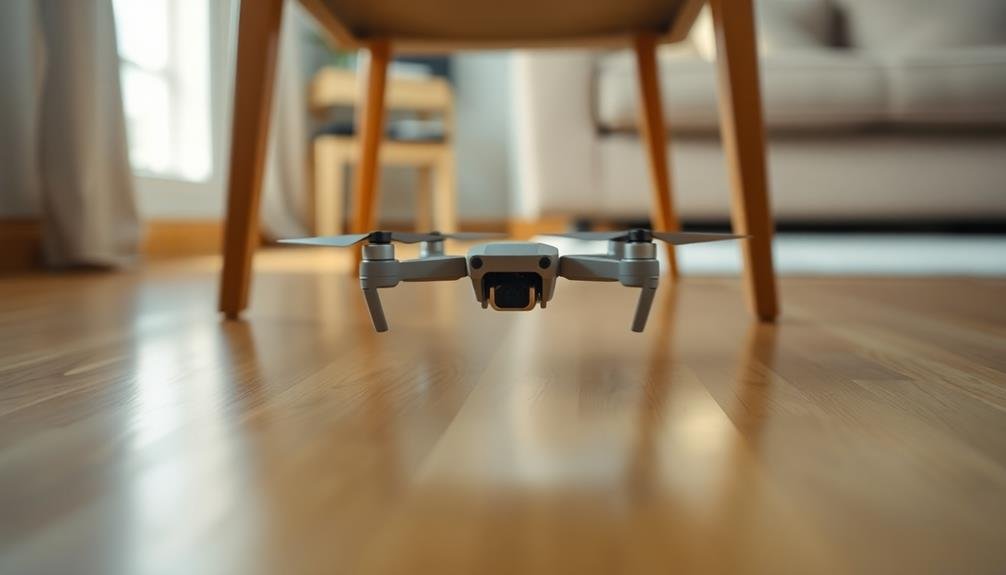
When flying indoors at low altitudes, mastering smooth corners and shifts is essential for capturing fluid footage.
You'll need to practice gentle, arc-like movements to navigate around objects and through doorways seamlessly.
Additionally, honing your obstacle avoidance techniques will help you confidently maneuver in tight spaces while maintaining a safe distance from walls, furniture, and other potential hazards.
Smooth Corners and Transitions
As you venture into low-altitude indoor flight, smooth corners and shifts become essential skills to master. These techniques allow you to create fluid, cinematic shots that captivate your audience. To execute smooth corners, maintain a consistent speed and use gentle stick movements. Anticipate turns by starting your adjustments early, gradually easing into the new direction.
For seamless changes between spaces, plan your route in advance. Identify potential obstacles and visualize your flight path. As you approach doorways or narrow passages, reduce your speed slightly and align your drone perpendicular to the opening. This approach minimizes the risk of clipping walls or furniture.
Practice these maneuvers to create stunning visual effects:
- Glide around a corner, revealing a hidden subject
- Smoothly shift from a low hallway into a spacious living room
- Execute a gentle arc around a centerpiece, showcasing its details
Remember to adjust your camera angle throughout these movements to maintain proper framing.
Obstacle Avoidance Techniques
Three essential obstacle avoidance techniques will help you perfect your low-altitude indoor maneuvers.
First, master the "stop and hover" technique. When approaching an obstacle, slow down and stabilize your drone in a hover. This allows you to assess the situation and plan your next move. Practice shifting smoothly from forward flight to a stable hover at various speeds and distances.
Next, learn the "side-slip" maneuver. As you approach an obstacle, shift your drone sideways while maintaining forward momentum. This technique is vital for traversing narrow corridors or passing through doorways. Focus on keeping your altitude steady and your movements precise.
Finally, perfect the "vertical dodge." When faced with obstacles at varying heights, quickly adjust your drone's altitude to pass over or under them. This requires excellent throttle control and spatial awareness. Start with slow, deliberate movements and gradually increase your speed as you gain confidence.
Combine these techniques for seamless obstacle avoidance. Practice in open spaces before attempting complex indoor environments.
Remember to always prioritize safety and adhere to local regulations when flying indoors.
Capturing Unique Perspectives and Angles
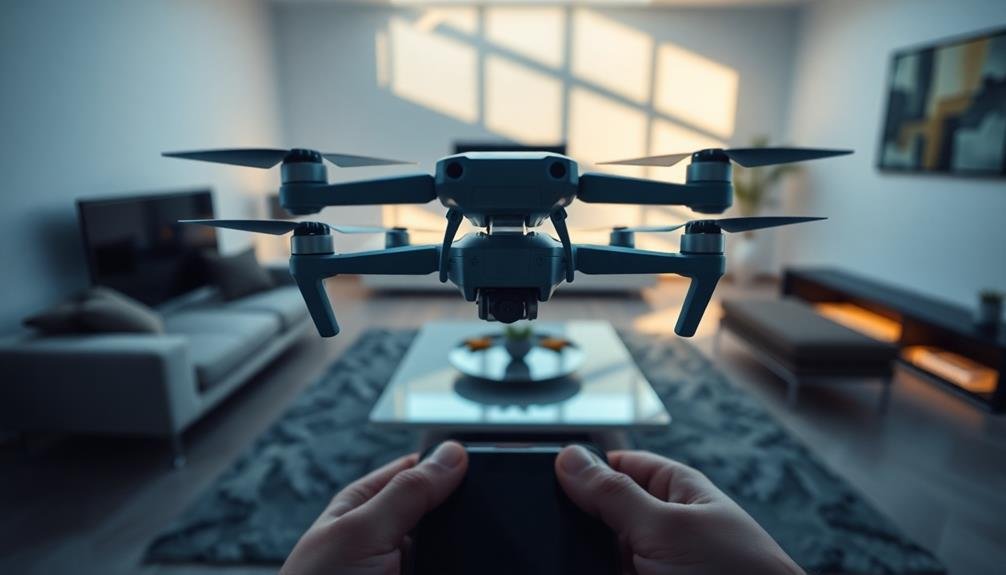
Indoor flight's allure lies in its ability to capture unique perspectives and angles that were once impossible to achieve. With a drone, you can explore spaces from entirely new vantage points, creating stunning visuals that fascinate your audience.
To make the most of these opportunities, focus on finding unconventional angles and utilizing the drone's maneuverability. Start by identifying interesting architectural features or focal points in the room. Fly your drone close to ceilings, corners, or intricate details to showcase them in ways traditional cameras can't.
Don't be afraid to experiment with unusual compositions, such as looking down staircases or through skylights. Remember to maintain smooth and controlled movements for professional-looking footage.
Consider these unique perspectives to create fascinating imagery:
- A birds-eye view of a grand foyer, revealing intricate floor patterns
- A low-angle shot gliding through a narrow corridor, emphasizing its length
- A reveal shot starting behind furniture, then rising to showcase the entire room
Navigating Tight Spaces Successfully
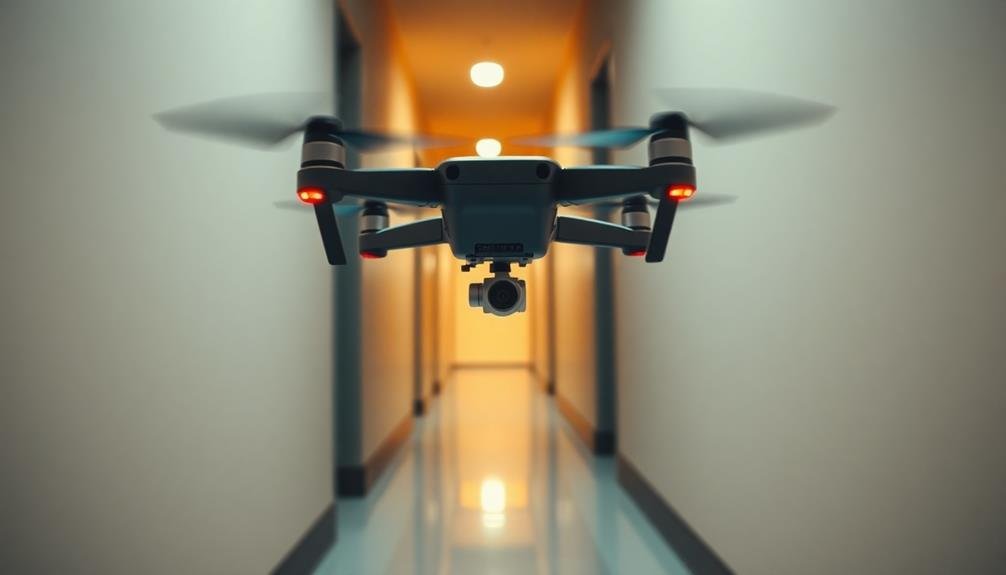
While capturing unique perspectives opens up new creative possibilities, you'll often face the challenge of maneuvering in confined areas. Steering tight spaces requires skill, practice, and the right techniques. Start by mastering precise throttle control and gentle stick movements. Use altitude hold mode to maintain steady height while focusing on horizontal movements.
When approaching narrow passages, slow down and assess the area. Identify potential obstacles and plan your route. If possible, use a spotter to help guide you through tricky sections. Consider flying backwards in extremely tight spots, as it's often easier to maneuver the drone's front end.
Here's a quick reference guide for steering tight spaces:
| Technique | When to Use | Key Points | Difficulty | Risk Level |
|---|---|---|---|---|
| Slow and Steady | Always | Maintain low speed, be cautious | Low | Low |
| Altitude Hold | Narrow horizontal spaces | Focus on forward/backward movement | Medium | Medium |
| Backwards Flight | Extremely tight areas | Better front-end maneuverability | High | High |
| Spotter Assistance | Complex environments | Extra set of eyes for safety | Low | Low |
| Practice Runs | Before attempting real shots | Familiarize with space, build skill | Medium | Low |
Enhancing Depth in Indoor Environments
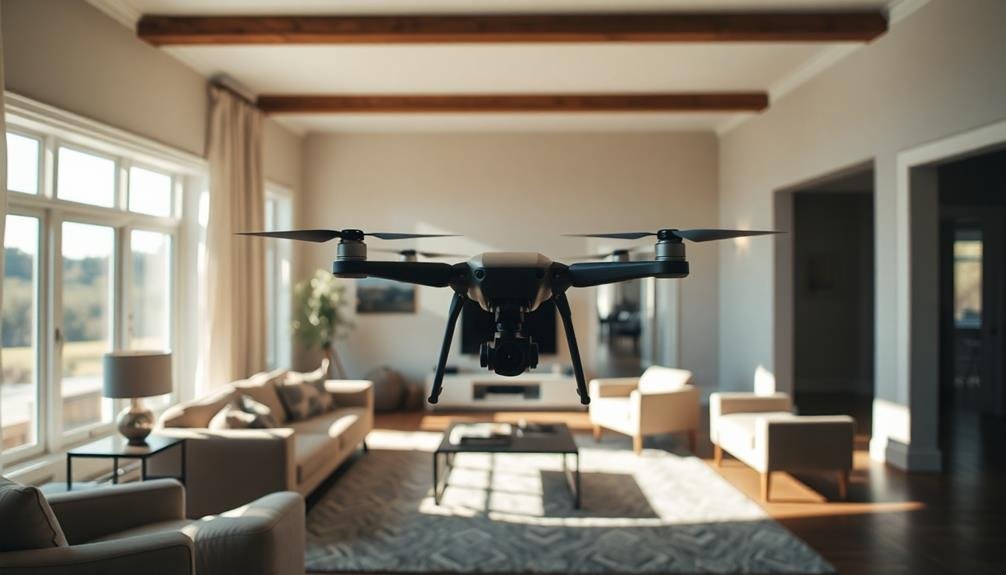
Beyond the challenge of navigation, creating a sense of depth in indoor drone footage can elevate your shots from ordinary to extraordinary. To achieve this, you'll need to take into account your camera settings, lighting, and composition carefully.
Start by using a wider aperture to create a shallow depth of field, which can help separate your subject from the background. You'll also want to play with foreground elements, placing objects closer to the camera to frame your shot and add layers to the scene.
Lighting plays a vital role in enhancing depth. Use natural light sources like windows or strategically placed artificial lights to create shadows and highlights. This contrast will add dimension to your footage.
When composing your shots, look for leading lines that draw the viewer's eye into the scene, such as hallways, staircases, or architectural features.
To create imagery in your audience's mind, take into account these visual elements:
- Sunbeams streaming through dusty windows, creating ethereal light patterns
- A winding spiral staircase, beckoning the viewer upward
- Ornate chandeliers casting intricate shadows on textured walls
Incorporating Dynamic Subject Movement

Dynamic subject movement breathes life into indoor drone footage, transforming static scenes into enchanting visual narratives. To incorporate this element, you'll need to carefully choreograph your subjects and drone movements.
Start by planning your shots, considering how your subjects will move through the space and how your drone can complement their actions.
Try following a subject as they walk through a hallway or climb stairs, maintaining a consistent distance. You can also create reveal shots by having your subject enter the frame as your drone moves backwards.
Experiment with orbiting shots, circling your subject as they perform an action. For added drama, combine vertical movements with your subject's actions, such as ascending as they reach the top of a staircase.
Remember to maintain safe distances and communicate clearly with your subjects. Practice these movements repeatedly to perfect your timing and control.
You can also use obstacles creatively, having your subject weave between furniture or columns as your drone follows. By mastering these techniques, you'll create dynamic indoor footage that captivates your audience and brings your scenes to life.
Post-Processing for Indoor Footage

Post-processing plays an essential role in enhancing your indoor drone footage. You'll want to focus on color correction, noise reduction, and stabilization to bring out the best in your shots.
Start by adjusting the white balance to counteract any artificial lighting issues, then fine-tune exposure and contrast to create a balanced look. Don't forget to address any shadows or highlights that may be too extreme.
Next, tackle any noise in your footage, especially if you've shot in low-light conditions. Use noise reduction tools carefully to maintain detail while smoothing out grainy areas.
For stabilization, apply warp stabilizer or similar effects to eliminate any remaining shake or jitter in your shots.
To create a cinematic feel, consider these post-processing techniques:
- Add a subtle vignette to draw attention to the center of your frame
- Apply color grading to establish a consistent mood throughout your video
- Incorporate subtle lens flares or light leaks for added atmosphere
Practice Exercises for Skill Improvement
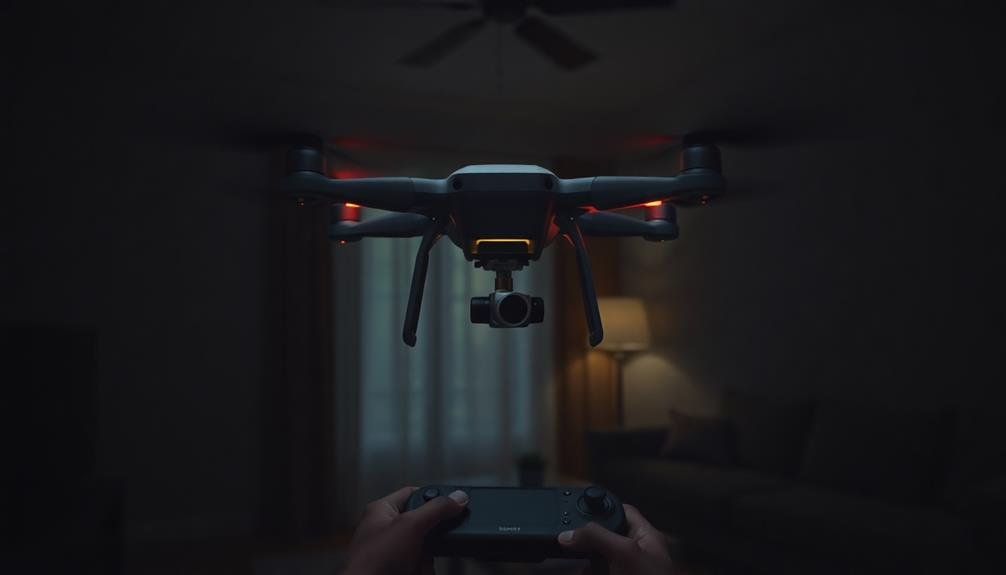
Mastering indoor drone flight requires consistent practice and targeted exercises. To improve your skills, start with hover drills. Position your drone at eye level and practice maintaining a steady hover for increasing durations. This builds your control and stability.
Next, try figure-eight patterns. Fly your drone in a horizontal figure-eight, gradually decreasing the size of the loops. This exercise enhances your precision and maneuverability in tight spaces.
Practice slow, controlled movements by flying your drone at the slowest possible speed from one point to another. This develops your finesse for smooth cinematic shots.
For obstacle navigation, set up a makeshift course using everyday objects. Fly through and around these obstacles, focusing on clean lines and avoiding collisions.
Work on your yaw control by rotating the drone 360 degrees while maintaining a fixed position. This improves your ability to capture panoramic shots indoors.
Lastly, simulate tracking shots by following a moving object, like a remote-controlled car. This hones your skills for dynamic indoor scenes.
Remember to start slow and gradually increase difficulty as you improve. Consistent practice with these exercises will greatly enhance your indoor flight capabilities.
Frequently Asked Questions
How Do I Handle Sudden Draft or Air Current Changes Indoors?
To handle sudden drafts or air currents indoors, you'll need to be alert and responsive. Adjust your drone's controls quickly, use obstacle avoidance features, and maintain a steady altitude. Practice flying in various conditions to improve your skills.
What's the Best Way to Soundproof Propellers for Indoor Filming?
You'll want to focus on propeller design and materials. Try using low-noise propellers, add rubber dampeners, or experiment with 3D-printed props. You can also use prop guards or consider switching to ducted fans for quieter operation.
How Can I Minimize Dust Particles Visible in Indoor Drone Footage?
You'll want to clean the area thoroughly before filming. Use an air purifier, close windows, and avoid disturbing surfaces. Fly slowly and adjust lighting to minimize visible particles. Consider post-processing to remove any remaining dust specks.
Are There Specific Indoor-Friendly Propeller Guards That Don't Affect Performance?
You'll find several indoor-friendly propeller guards that won't greatly impact performance. Look for lightweight, low-profile options like snap-on guards or pop-up shields. They'll protect your drone and surroundings without compromising flight characteristics or video quality.
How Do I Manage Battery Life When Filming Multiple Indoor Locations?
You'll want to carry spare batteries and a charger. Plan your shots efficiently, use power-saving modes, and minimize unnecessary flight time. Consider investing in high-capacity batteries and a portable charging station for extended shoots.
In Summary
You've now got the tools to create stunning indoor drone footage. Remember, it's all about practice and patience. Don't be afraid to experiment with different techniques and angles. As you refine your skills, you'll find your unique style emerging. Keep safety in mind, respect privacy, and always push your creative boundaries. With these tips, you're well on your way to capturing breathtaking indoor cinematic shots that'll wow your audience.

As educators and advocates for responsible drone use, we’re committed to sharing our knowledge and expertise with aspiring aerial photographers.
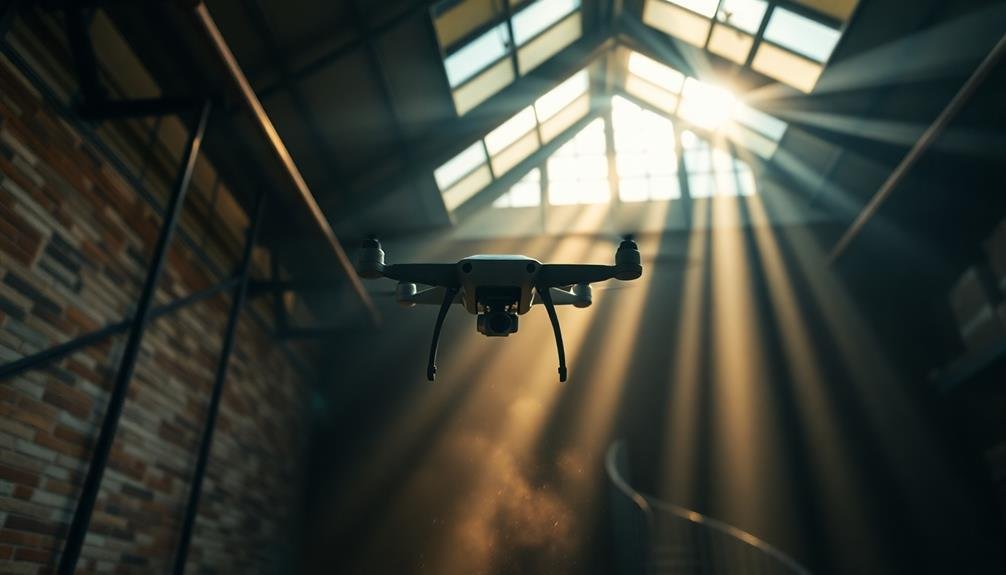



Leave a Reply